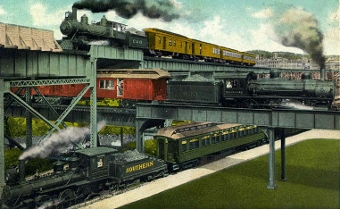I now have in my possession – courtesy of a friend who has recently moved and could not take with him all that he had owned – about a half-dozen books and roughly four times as many magazines, in one way or another all having to with railroading, thus adding to my library of such.
Needless to say, I have thus far read through several. And, one of the magazines (Locomotive 2010) had a passage in one of the included articles (“Passage of time: Rio Grande 5371 was the last of a breed”) that struck a chord, the thought here being: “Will 5371 be the sole example preserved for future generations?”
What is special about this particular diesel locomotive (a General Motors, Electro-Motive Division model SD40T-2 which, in this case, just so happens to wear Denver & Rio Grande Western railroad colors and sport the 5371 number), is its built-in air-intake provision which enabled the model to better perform in walled-in spaces like tunnels with their typically limited air and/or air-circulation characteristics, compared to locos without such provisions built in, hence their earning the “tunnel motor” qualifier. The diesel, incidentally, sits among the collection of railway equipment housed at the Ogden Railroad Museum in Utah having taken up residence there since Aug. 2009, according to Mike Danneman, the article’s author.

The preservation, restoration and operation of representative examples of many historical, special, unusual, unique, etc. locomotives is a common practice the world over, no question. In fact, pulled behind some of the preserved, restored and operating locos at a few operating museums and tourist pikes are passenger cars on or inside which I have ridden. On rare occasion, I have been invited up into the locomotive cab and, in one case I even got to operate the loco itself.
Meanwhile, in yet another issue of Locomotive, this time for year 2007, in the “Editor’s Notebook” section, Editor Greg McDonnell wrote: “Locomotive emissions standards – smoke abatement laws by another name – are again a hot ticket. Again, they’re helping to spark a new revolution in locomotive technology.” Again, another one of those thoughts that hits home.
Here it is, almost May 2016, and if I remember correctly, all purchases of new diesel locomotives, I think as of the end of 2015, had to meet Tier 4 emissions standards – for operation inside America’s borders. What this means, if true, is that locomotive builders such as General Electric and Progress Rail Services, for example, have been hard at work creating products that meet (or exceed) these latest of requirements. That’s great news!
One thought leading to another, now I can’t help but think of all the progress air-quality related-wise that has been made in the area of locomotive technology development.
This may come as a shock and the statement I am about to make may raise a few hackles, and that statement is that for all the progress that’s been made, I can’t help but believe that some of that success, yes, success, is being countervailed, at least to some extent, by the allowance of the operation of steam locomotives across the continent. With rare exception, these fire-eating, smoke-belching contraptions are so notoriously damaging on air that it is any wonder that they are even allowed to operate at all. I’d really be surprised to find at my mentioning this if I haven’t at least ruffled a few feathers.
So, the question becomes: If the builders turning out the most fuel-efficient, cleanest-burning diesel locomotives in the land are complying with standards which are helping improve the quality of air, not to mention saving the railroads that use them a considerable sum of money over the long haul and therefore helping the railroad companies’ bottom lines, why is there not a similar set of air-compliant qualifications that these steam locomotive operators be likewise held to?
If the Grand Canyon Railway, with the conversion of one of its steam locomotives that now enables it to burn waste vegetable oil (WVO) compared to what this particular iron horse once combusted (be it coal or other fossil fuel) and thereby allowing this one steam locomotive to burn far, far cleaner, if GCR can do it (and, presumably, as a result of the conversion made, not only is the company able to benefit, but communities along the railroad’s path), so too should others running similar operations do likewise (that is, have steam locomotives on their pikes undergo like conversions)! What’s smart is smart and this smells smart to me.
– Alan Kandel
![320px-WilliamsDepot_WilliamsAZ[1]](https://alankandel.scienceblog.com/files/2013/02/320px-WilliamsDepot_WilliamsAZ1.jpg)